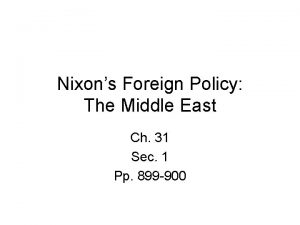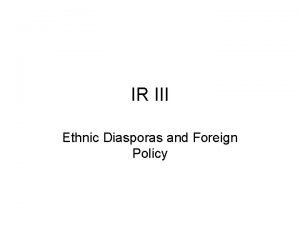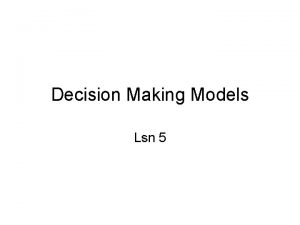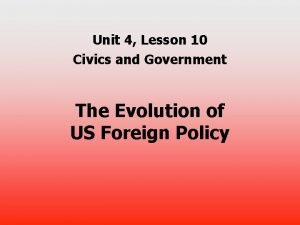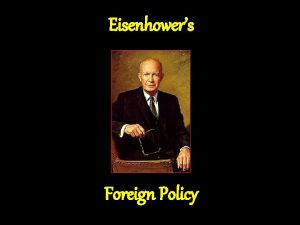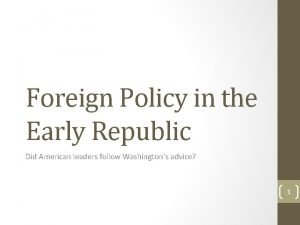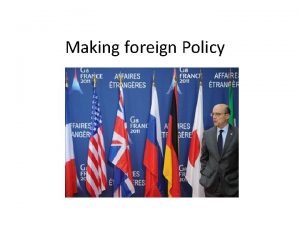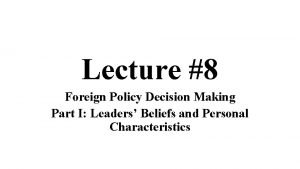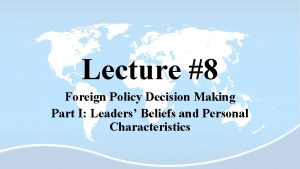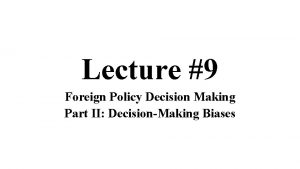Lecture 9 Foreign Policy Decision Making Part II

















- Slides: 17

Lecture #9 Foreign Policy Decision Making Part II: Decision-Making Biases

Introduction • Research in psychology has shown that humans are limited information processors with a range of blind spots (many of them predictable and recurring)

Introduction • Political psychologists have applied these findings to foreign policy decision-making and shown that key psychological biases affect outcomes in IR • Classic example: Jervis, Perception and Misperception in International Politics

Group decision-making biases • Groupthink • Irving Janis’ classic study of foreign policy fiascos (Bay of Pigs, Vietnam, etc. ) • Definition: excessive concurrence seeking (highest priority is achieving/maintaining group consensus and good relations, not reaching best possible decision)

Group decision-making biases • Groupthink • Symptoms • Overestimation of group power/morality • Closed-mindedness (incomplete survey of information, options, and risks/consequences) • Pressures toward uniformity

Group decision-making biases • Groupthink • Causes • Collegiality • Insulation • No tradition of impartial leadership • Lack of clear decision-making methods

Group decision-making biases • Group polarization/choice shift • Can occur in groups with shared values/preferences • Group chooses more extreme option than any individual would have chosen • Examples: risk-taking, racial/sexual prejudice, juries’ punitive damage rewards • Likely mechanisms: diffusion of responsibility, social desirability, increased number of persuasive arguments

Individual decision-making biases • Four types of Individual Decision-Making Biases • Prospect Theory • Mirror-Imaging • Attribution Biases • Motivated Biases

Individual decision-making biases • Prospect theory • Challenge to rational choice theory • Predicts people will be: • Risk-averse in the domain of gains • Risk-seeking in the domain of losses • A person’s reference point (determining which domain they are in) is thus crucial

Individual decision-making biases • Prospect theory (cont. ) • “Endowment effect” helps explain these findings: people value what they possess more than an equally attractive alternative • Implications for IR: • Leaders will take greater risks to protect current resources than gain new ones • Equal trades are unattractive; bias toward status quo in negotiations (e. g. , Israeli- Palestinian conflict)

Individual decision-making biases • Mirror-imaging • Definition: the common human tendency to assume that other actors share one’s: • Values • Perceptions • Cost-benefit calculations

Individual decision-making biases • Mirror-imaging (cont. ) • A major cause of intelligence failures and strategic surprise: • Often a stronger country/coalition believes an attack by a weaker side would be irrational and assumes the weaker party shares this view (rendering them unprepared) • Japanese attack on Pearl Harbor • Chinese intervention in Korea • Egyptian/Syrian attack on Israel in Yom Kippur War • Saddam Hussein’s refusal to pull out of Kuwait in 1990/91

Individual decision-making biases • Attribution biases • Psychologists have identified several different types of attribution biases. Two are especially relevant for IR: • Actor-observer Bias • Motivated Biases

Individual decision-making biases • Actor-observer bias: • people tend to attribute others’ behavior to their disposition (internal character) but attribute their own behavior to situational pressures • May lead decision-makers to attribute overly hostile intentions to other states • Different attributions depending on whether the foreign actor is friend or foe

Individual decision-making biases • Actor-observer bias: (cont. ) • Positive act by ally: dispositional attribution (“they are a good friend”) • Negative act by ally: situational attribution (“they were forced to do it”) • Positive act by enemy: situational attribution (“they were compelled to do it”) • Negative act by enemy: dispositional attribution (“they are an evil country”) • These patterns may blind one to a potential overture from an enemy or warning signs in an ally’s behavior

Individual decision-making biases • Motivated biases • “Wishful thinking”: you want something to be the case so badly you convince yourself it is true and ignore/discount evidence to the contrary • “Rational, ” or “cold” calculations are inhibited by “hot” emotions or underlying motives

Individual decision-making biases • Motivated biases (cont. ) • Examples: • Leaders who earnestly desire peace may appease aggressive adversaries, convincing themselves these strategies will be successful. • Leaders who desire to prevail in a military confrontation may discount the capabilities of their opponent (or inflate their own) because they want so badly to be victorious. • These tendencies may be exacerbated by group dynamics (see groupthink and group polarization).
 Objectives of decision making
Objectives of decision making Financial management process
Financial management process So here you are too foreign for home
So here you are too foreign for home 1790 foreign policy
1790 foreign policy Foreign policy of louis philippe
Foreign policy of louis philippe What was thomas jefferson foreign policy
What was thomas jefferson foreign policy Nixons foreign policy
Nixons foreign policy Nixons foreign policy
Nixons foreign policy Actors in foreign policy
Actors in foreign policy Definition of foreign policy by scholars
Definition of foreign policy by scholars Chapter 33 section 4 foreign policy after the cold war
Chapter 33 section 4 foreign policy after the cold war Actors in foreign policy
Actors in foreign policy Unit 4 lesson 10 american foreign policy
Unit 4 lesson 10 american foreign policy Truman foreign policy vs eisenhower
Truman foreign policy vs eisenhower Interwar foreign policy
Interwar foreign policy Lesson 5 american foreign policy
Lesson 5 american foreign policy Hitler's foreign policy timeline
Hitler's foreign policy timeline Foreign policy in the early republic
Foreign policy in the early republic







